There’s something special about a good Chicken Stir Fry. The combination of juicy chicken, crispy vegetables, and savory sauce is always a winner in my book. Plus, it’s the perfect dish for a busy weeknight meal. This stir fry recipe is easy to follow and sure to become a family favorite.
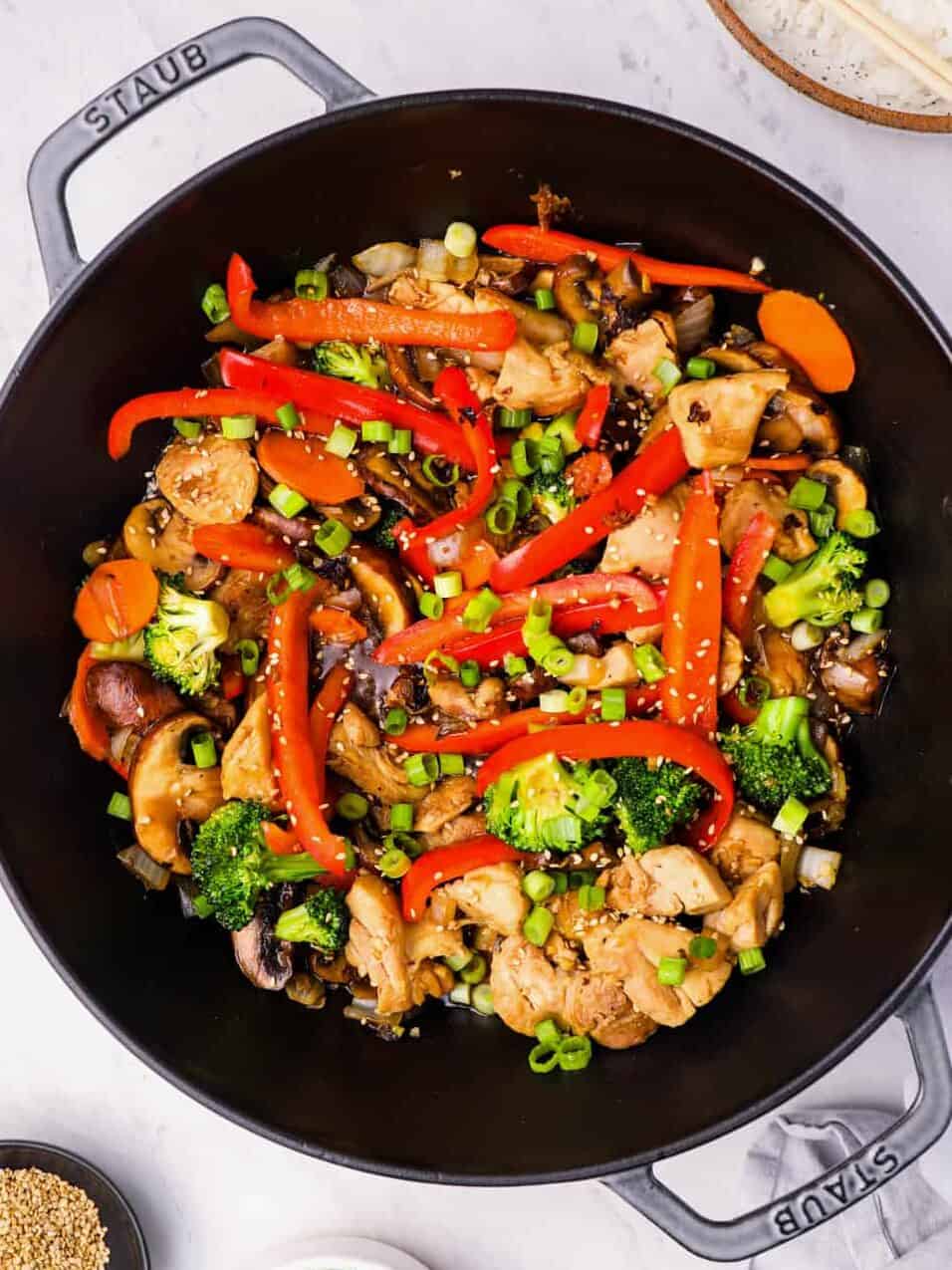
This post may include affiliate links that earn us a small commission from your purchases at no extra cost to you.
What’s in this Chicken Stir Fry Recipe?
Chicken and Vegetable Stir Fry is a quick, healthy, and delicious meal that can be made with just a few simple ingredients. The combination of fresh vegetables, succulent chicken, and savory sauce is simply irresistible.
- Chicken Broth: Adds a savory, umami flavor to the sauce.
- Water: Helps thin the sauce to the right consistency.
- Soy Sauce: Adds saltiness and umami flavor.
- Honey: Adds a touch of sweetness to the sauce.
- Cornstarch: Helps thicken the sauce.
- Toasted Sesame Oil: Adds a toasty, nutty flavor to the sauce.
- Olive Oil: Helps the chicken cook without burning it.
- Chicken Thighs: Have a rich, juicy flavor. You can also use chicken breasts if you prefer.
- Vegetables: Carrot, broccoli, red bell pepper, mushrooms, and onion. Cut the vegetables into similarly-sized pieces so that they cook evenly.
- Garlic: Adds an earthy flavor.
- Ginger: Adds a bright, spicy flavor.
- Jasmine Rice: The perfect base to soak up all of that delicious sauce.
Pro Tip: You can cook this stir fry in any neutral oil, such as canola or vegetable.
Variations on Stir Fry Chicken
- To make the sauce gluten-free, swap the soy sauce for tamari or coconut aminos.
- Instead of chicken thighs, try chicken breasts, shrimp, sliced steak, or tofu!
- Feel free to swap in your favorite vegetables, such as snow peas, bok choy, green beans, snap peas, edamame, asparagus, zucchini, or cauliflower.
- For a spicy stir fry, add in some crushed red pepper flakes!
- You can serve this stir fry over brown rice or noodles instead of Jasmine rice.
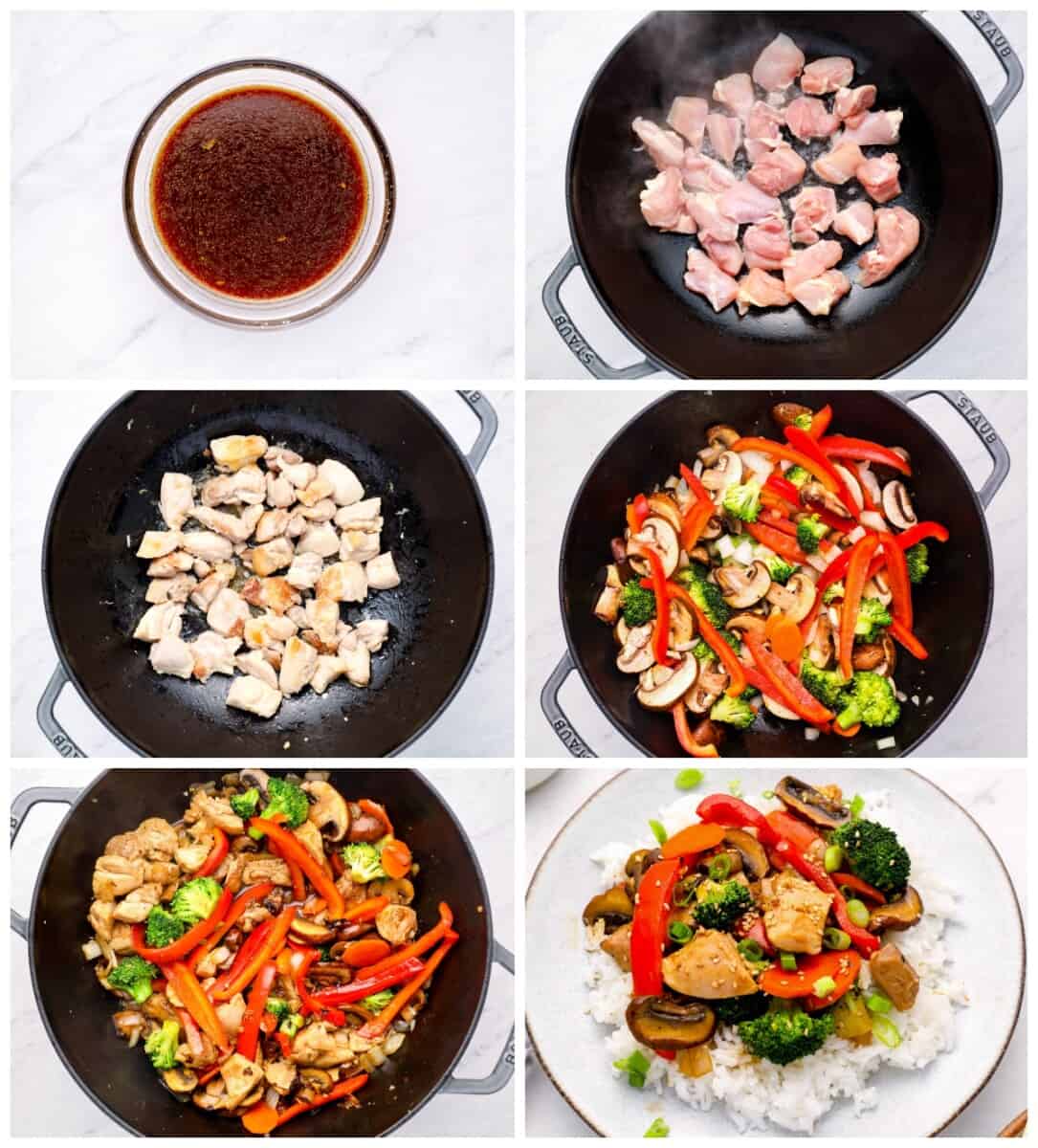
I like to use chicken thighs because they are flavorful and less likely to overcook, but you can absolutely use chicken breasts instead.
The chicken will get cooked first and set aside until the end to ensure that it doesn’t dry out!
I love to use carrots, broccoli, bell pepper, mushrooms, and onions, but you can use almost any vegetable in this stir fry. Try snow peas, bok choy, green beans, snap peas, edamame, asparagus, zucchini, or cauliflower.
Nope! If you like spice, you can add crushed red pepper flakes to increase the spice level. Start with ⅛ teaspoon and increase until you reach the desired level of spice.
If your chicken stir fry seems lumpy, you may not have whisked the sauce together enough. The sauce contains cornstarch, a thickening agent that works best when dissolved in a cool or room-temperature liquid and added to a hot pan of food. If the cornstarch is not fully dissolved in the sauce first, it can clump up when exposed to heat, leading to a lumpy stir fry.
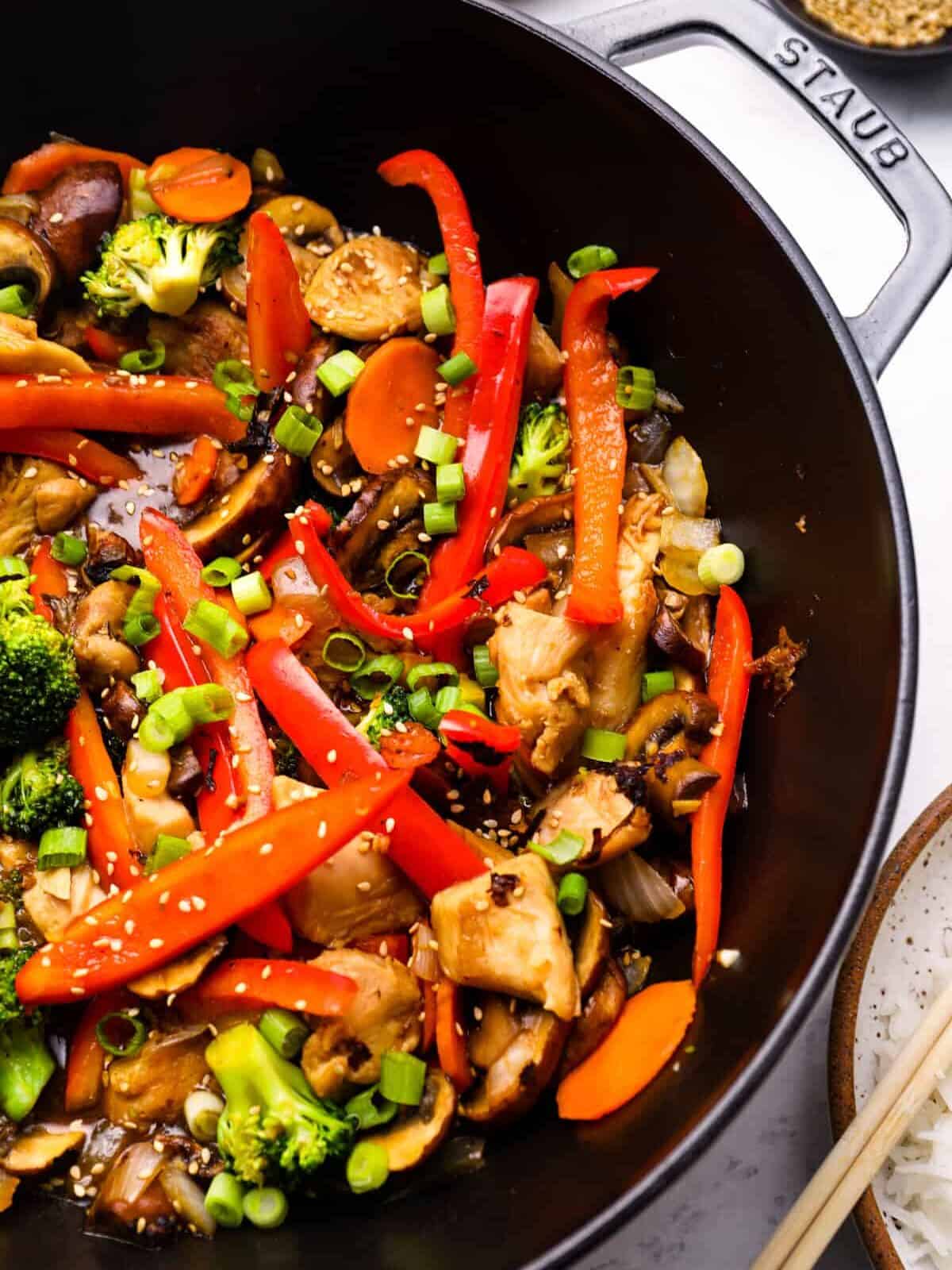
How to Make Ahead and Store
You can chop and prepare all of the vegetables up to 1 day in advance of when you plan to cook this stir fry. Store the cut vegetables in airtight containers in the refrigerator until ready to use.
Store leftover chicken stir fry in an airtight container in the refrigerator for up to 3 days.
How to Freeze and Reheat
Freeze chicken stir fry whole or in individual portions in airtight containers or Ziplock bags for up to 3 months. Let thaw overnight in the refrigerator before reheating in the microwave in 30-second intervals until hot.
Serving Suggestions
Chicken stir fry can be served over rice or combined with other Chinese dishes like fried rice, lo mein, egg rolls, egg drop soup, cucumber salad, or crab rangoon.
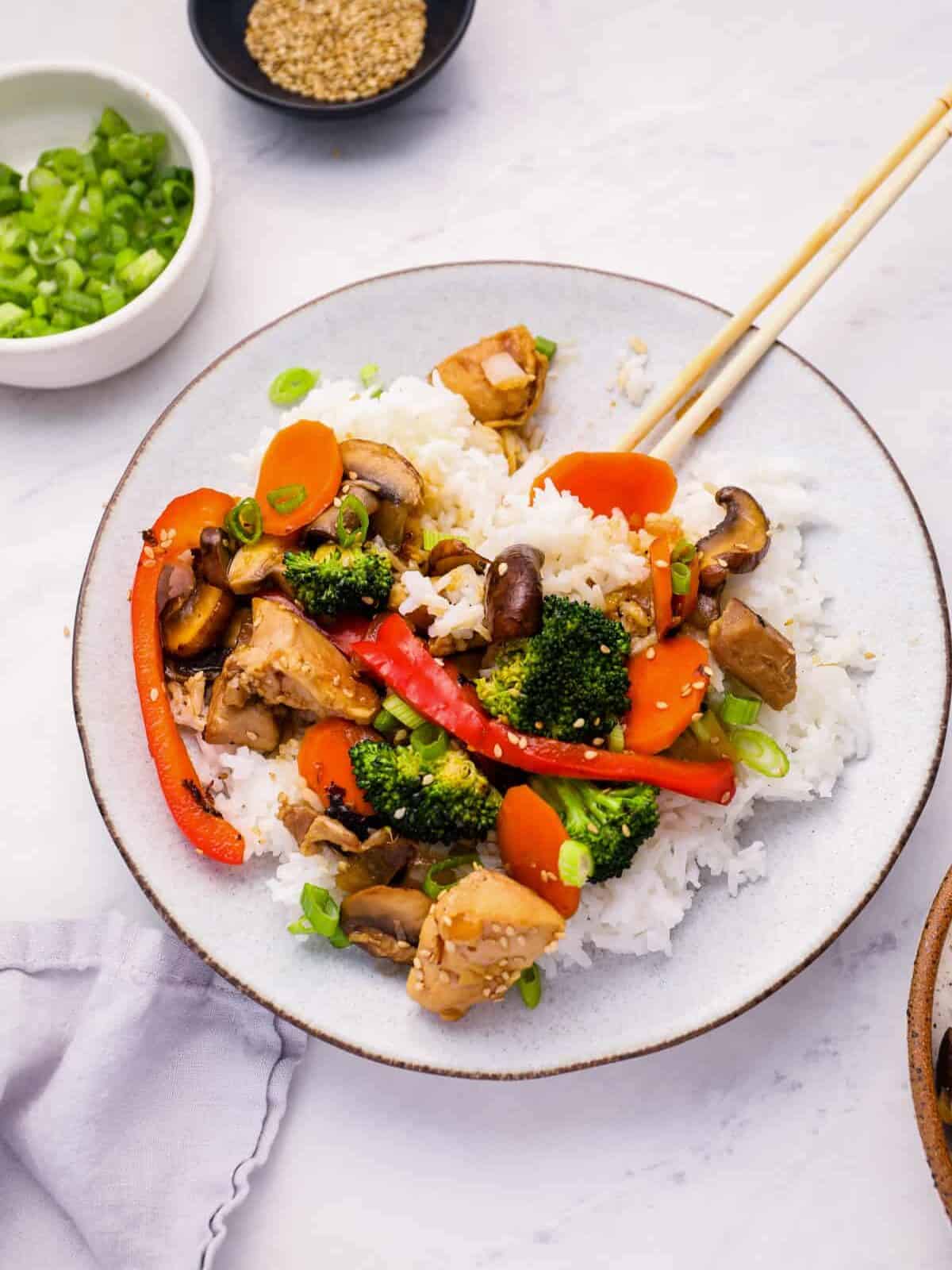
Chicken Stir Fry Recipe
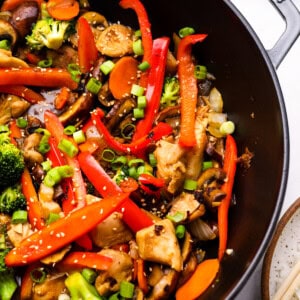
Ingredients
For the Stir Fry Sauce
- ½ cup low-sodium chicken broth
- ¼ cup water
- ¼ cup low-sodium soy sauce (see note)
- 2 tablespoons honey
- 1 tablespoon cornstarch
- 2 teaspoons toasted sesame oil
For the Stir Fry
- 2 tablespoons olive oil
- 1 pound boneless, skinless chicken thighs cut into bite-sized cubes
- ½ carrot sliced
- 2 cups broccoli florets
- 1 red bell pepper sliced
- 8 ounces mushrooms sliced
- ½ onion chopped
- 4 cloves garlic minced
- 1 teaspoon minced fresh ginger
- 1 green onion sliced; optional, for garnish
- 1 tablespoon sesame seeds optional, for garnish
- 3 cups cooked jasmine rice for serving
Instructions
- In a small bowl, whisk all the stir fry sauce ingredients together. Set aside.½ cup low-sodium chicken broth, ¼ cup water, ¼ cup low-sodium soy sauce, 2 tablespoons honey, 1 tablespoon cornstarch, 2 teaspoons toasted sesame oil
- In a wok or large sauté pan, heat the oil over medium-high heat until it shimmers. Add the chicken in a single layer. Cook, stirring occasionally, until golden brown and cooked through, about 5-7 minutes. Remove from the pan and set aside.2 tablespoons olive oil, 1 pound boneless, skinless chicken thighs
- Add in the carrot, broccoli, bell pepper, mushrooms, and onion. Cook, stirring often, until the vegetables are crisp tender, about 3-4 minutes.½ carrot, 2 cups broccoli florets, 1 red bell pepper, 8 ounces mushrooms, ½ onion
- Add in the garlic, ginger and cook for another 30-60 seconds until fragrant.4 cloves garlic, 1 teaspoon minced fresh ginger
- Pour the stir fry sauce into the pan and add in the chicken. Cook, stirring often, until the sauce thickens and coats the stir fry.
- Garnish with green onion and sesame seeds, and serve over cooked rice.1 green onion, 1 tablespoon sesame seeds, 3 cups cooked jasmine rice
Video
Becky’s Tips
- Soy Sauce: For a gluten-free alternative, use tamari or coconut aminos in place of the soy sauce.
- You can cook this stir fry in any neutral oil, such as canola or vegetable.
- Instead of chicken thighs, try chicken breasts, shrimp, sliced steak, or tofu!
- Feel free to swap in your favorite vegetables, such as snow peas, bok choy, green beans, snap peas, edamame, asparagus, zucchini, or cauliflower.
- For a spicy stir fry, add in some crushed red pepper flakes!
- You can serve this stir fry over brown rice or noodles instead of Jasmine rice.
- Cut the vegetables into similarly-sized pieces so that they cook evenly.
- If the pan seems dry after cooking the chicken, add another tablespoon of oil.
- Sauté the vegetables until crisp-tender, not soft. This will prevent a mushy stir fry.
- Let the sauce come to a simmer after adding it in order to allow the cornstarch to activate and thicken.
Nutrition information is automatically calculated, so should only be used as an approximation.









I made it today and it’s delicious. Thanks.
We’re sorry to hear this recipe didn’t work out for you! The sauce is meant to cook down and thicken over time!
Turned out very good! I added bamboo shoots and water chestnuts. We served over jasmine rice and wild rice/quinoa and a sprinkle of cayenne.